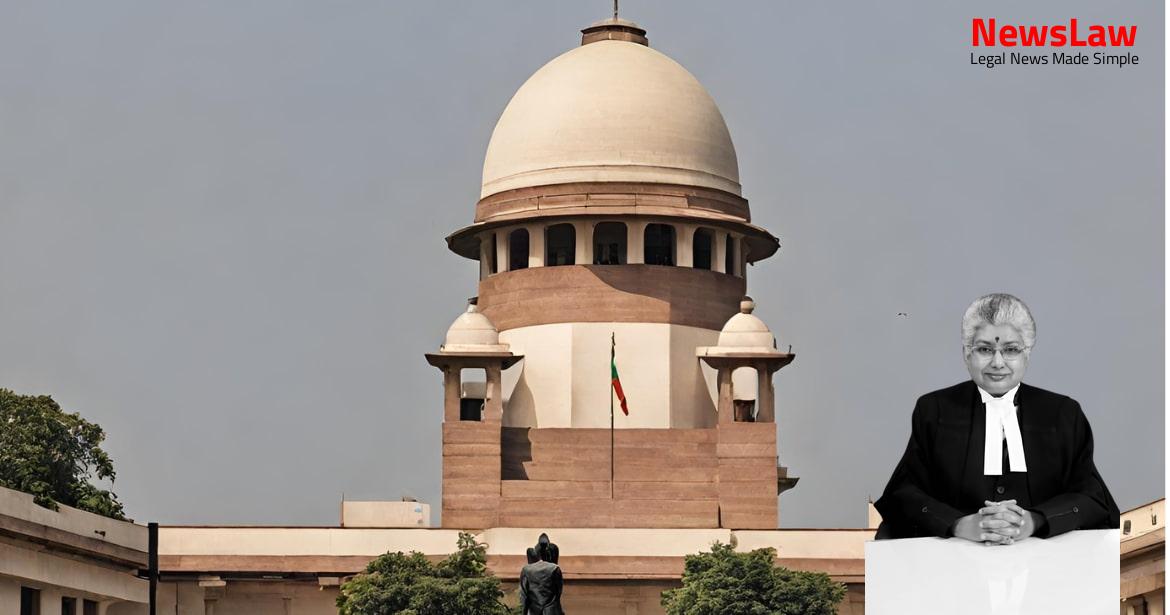Explore the detailed legal analysis by the court regarding the interpretation of limitation periods in stamp duty refund cases. The court’s nuanced approach to statutory provisions and equitable principles provides crucial insights into the complexities of refund claims in the legal realm. Dive into the in-depth examination of limitation periods and judicial discretion in this informative blog post.
Facts
- The appellant paid Rs 1,58,28,221 out of the agreed consideration on 14 August 2014.
- The appeal was filed before the Chief Controlling Revenue Authority under Section 53(1A) of the Maharashtra Stamp Act 1958.
- The petition was dismissed, leading to the rejection of the application for a refund of stamp duty by the Deputy Inspector General of Registration and Deputy Controller of Stamps, Pune.
- Eventually, the complaint was allowed on 6 May 2016.
- The appellant initially booked a residential flat for Rs 1,68,88,095 on 24 April 2014.
- An interim order dated 25 September 2014 restrained the developer from creating third-party interests in the flat during the pendency of the complaint.
- The appeal was dismissed on 2 April 2018.
- The appellant purchased an e-SBTR stamp paper for Rs 8,44,500 for the execution of the agreement to sell.
- A claim for the refund of stamp duty was rejected due to the expiry of the six-month period.
- The appellant opted for a refund of the price after a dispute with the builder.
- The appellant lodged a consumer complaint, leading to a judgment on 22 November 2018 of the High Court of Bombay.
- The developer refunded the consideration as per the order of the NCDRC.
- The appellant exercised the option of seeking a refund of consideration together with interest.
- The appellant initially paid Rs 33,91,795 representing 19.9% of the agreed sale consideration by July 2014.
- A writ petition was filed in the High Court challenging orders and seeking a refund of the stamp duty.
- The application for refund was rejected by the Deputy Inspector General of Registration on the basis of the six-month limitation.
- The Collector of Stamps recommended denying the refund for not applying within six months.
- Sections 47, 48, 52, and 52A of the Act need to be interpreted harmoniously.
- An application under Section 52A must be made within six months from the date of purchasing the stamps.
- The High Court, in its judgment, dismissed the petition as the application for refund was considered time-barred.
- The argument that the six-month limitation under Section 48(3) would not apply to cases under Section 52A was rejected.
- The Bombay High Court upheld the decision, deeming the claim to be stale.
Also Read: Electoral Malpractices in Mayor Election
Arguments
- The appellant purchased e-stamp paper on 16 August 2014.
- Dispute with the developer led appellant to approach NCDRC, with an interim stay granted on 25 September 2014 and final complaint allowed on 6 May 2016.
- Application for refund was made on 16 July 2016.
- Reasons provided by counsel for filing application within a reasonable period include – ongoing dispute with the developer, bona fide purchase of e-stamp paper, necessity to retain it for NCDRC proceedings, potential use if dispute resolution with developer had occurred, and seeking refund post NCDRC order.
- Counsel for the appellant relied on a judgment of a two-Judge Bench in Committee-GFIL vs Libra Buildtech Private Limited and Others.
- Opposing the submissions, Mr. Rahul Chitnis, Chief Standing Counsel for the State of Maharashtra, argued against the appellant’s points.
Also Read: Balancing Power and Transparency: Electoral Bonds Struck Down, Disclosure Mandated
Analysis
- Section 47 covers three classes of cases: spoiled, obliterated, and unfit for the purpose
- Refund can be sought under statutory provisions
- Controversy over whether appellant’s case falls under third category of being unfit for purchase purpose
- Section 50 allows for allowance for misused stamps
- Application filed by appellant did not fall under Sections 47, 52, and 52A
- Interpretation of ‘purpose’ is crucial in the context of the provision
- Section 52A overrides jurisdiction of adjudicating authority in certain cases
- Limitation periods vary depending on the section applicable to the claim
- Appellant’s case does not fall under Sections 47, 49, or 50
- Section 52A applies when stamp value exceeds Rs 5 lakhs, diverting power to relevant authorities
- Limitation period interpretation crucial in determining application validity
- Equity and restitution principles apply in interpreting refund claims
- Interpretation should avoid invidious discrimination
- Section 52A of the Maharashtra Stamp Act, 1958 operates notwithstanding anything in Sections 47, 50, 51, and 52.
- Application for relief under section 47 must be made within specified periods as mentioned in clauses (1), (2), and (3).
- Section 47 allows for allowance for spoiled stamps under specific circumstances outlined in clauses (a) to (c).
- Section 48 specifies the time period within which an application for relief under section 47 should be made.
- The application for allowance under Section 47 must be made within the prescribed period and subject to rules made by the State Government.
- Section 52A introduces provisions for allowances for duty exceeding a specified amount, with the decision-making authority depending on the amount of duty paid.
- The two-judge Bench of the Court dealt with the issue of limitation prescribed in the Indian Stamp Act 1899.
- Successful bidders had deposited the entire sale consideration along with the stamp duty with the committee.
- The transaction was cancelled due to reasons beyond the control of the parties.
- The Court directed the committee to refund the sale consideration with interest.
- The purchasers were permitted to approach the State Government for a refund of the stamp duty.
- A litigant has no control over judicial delays.
- Rejection of the application for refund would violate equity, justice, and fairness if the applicant suffers due to judicial delay.
- Exercise of power under Article 142 must not ignore statutory provisions, but must consider them and exercise discretion cautiously.
- If a statute prescribes a limitation period, the court must be cautious in interfering with the delay under Article 142.
- Court can condone delay under Article 142 in cases not covered by statute to deliver complete justice.
- Delay in filing the refund application was due to prolonged proceedings before NCDRC, so the application cannot be rejected on grounds of delay.
- Exercise of power under Article 142 is justified in this case due to delay caused by prolonged proceedings.
Also Read: Recall of Resolution Plan Approval: Legal Analysis
Decision
- The appeal has been allowed and the impugned judgment and order of the Bombay High Court dated 22 November 2018 have been set aside.
- No costs shall be ordered in the circumstances of the case.
- The appellant is entitled to a refund of the stamp duty paid for the e-stamp paper upon returning it to the Collector of Stamps, Mumbai.
- The refund process must be completed within one month of delivering the e-stamp paper to the Collector.
- The appellant is entitled to interest at a rate of 6% per annum from 16 July 2016 until the date of refund.
- Any pending applications are now disposed of.
Case Title: MR. RAJEEV NOHWAR Vs. CHIEF CONTROLLING REVENUE AUTHORITY MAHARASHTRA STATE PUNE (2021 INSC 540)
Case Number: C.A. No.-005970-005970 / 2021



